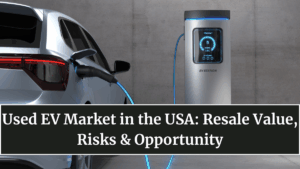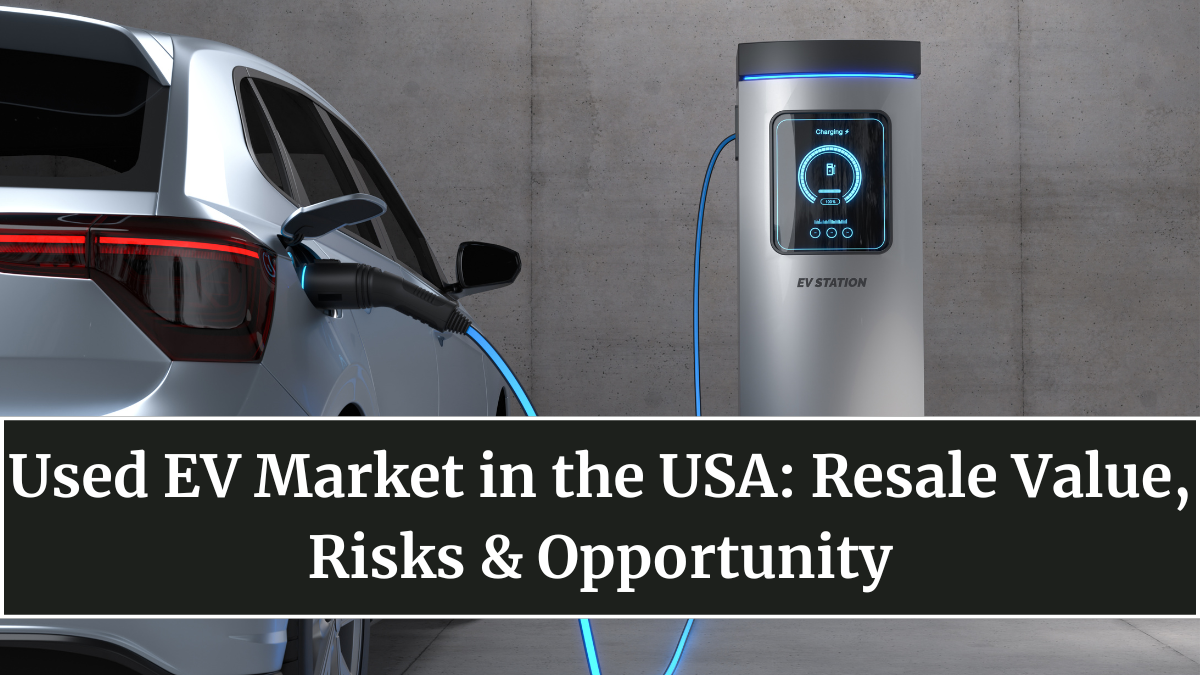The American used car market is entering a new phase — one defined by silence instead of engine noise. The used EV market in the USA is expanding rapidly as thousands of electric vehicles from early adopters are now hitting resale lots. For the first time, buyers can explore affordable pre-owned EVs without paying premium prices. But behind this growing opportunity lies a complex mix of battery health concerns, resale value fluctuations, and technological upgrades that are reshaping how Americans buy and sell used electric cars.

How the Used EV Market Evolved
A few years ago, used EVs were rare, mostly limited to early models like the Nissan Leaf and Chevrolet Bolt. However, by 2025, a massive wave of Tesla Model 3s, Ford Mustang Mach-Es, Rivians, and Hyundai Ioniq 5s are entering the resale market as lease cycles end and trade-ins increase.
This surge has made used EVs more accessible to average consumers — with prices dropping by nearly 30–40% compared to new models. Platforms like Carvana, Autotrader, and Tesla’s Certified Pre-Owned program are driving transparency and trust in EV resales, helping normalize electric ownership across the country.
Resale Value: The New Reality
Unlike internal combustion engine (ICE) cars, the resale value of EVs depends heavily on battery health, range, and software updates. The good news? As technology improves, batteries are lasting longer than expected. For example, Tesla’s battery degradation rates have averaged just 10% after 160,000 km, a strong indicator of long-term durability.
However, depreciation remains higher for certain older models due to limited range and lack of fast-charging compatibility. On the flip side, newer EVs with longer range and active software support — such as over-the-air updates and improved performance modes — maintain better resale prices.
What Buyers Should Look For
Before purchasing a used electric car, American buyers are advised to evaluate more than just mileage. Some critical checks include:
-
Battery health report: Equivalent to an engine inspection in ICE vehicles.
-
Charging history: Frequent use of fast charging can affect battery lifespan.
-
Warranty coverage: Most EVs have 8-year battery warranties — check transfer eligibility.
-
Software version: Updated systems often include range improvements or bug fixes.
-
Service records: Ensure proper cooling system and inverter maintenance.
Additionally, verifying whether the car qualifies for federal or state-level used EV tax credits (up to $4,000 for eligible vehicles) can significantly reduce costs.
Key Trends in the Used EV Landscape
Several factors are influencing the used EV resale value landscape in the USA today:
-
Tax credit expansion under the Inflation Reduction Act, which now includes certain used EVs.
-
Falling battery costs, making replacements or upgrades more affordable.
-
Dealer-certified EV programs that reassure buyers of vehicle quality.
-
Growing EV infrastructure — better charging networks increase desirability of used EVs.
-
Fleet liquidations, with delivery and rideshare companies selling bulk EVs after lease terms.
Together, these trends are creating a more mature and balanced secondhand electric vehicle ecosystem.
Risks & Challenges in the Market
While opportunities abound, some risks persist. Battery degradation, unverified import models, or unavailable software updates can make some used EVs risky purchases. The fast pace of EV innovation also leads to quicker model obsolescence — new cars with improved range or tech may outdate older ones faster than traditional vehicles.
Buyers should also be cautious about charging compatibility — some older EVs lack access to newer ultra-fast chargers. Experts recommend consulting verified dealerships or EV inspection specialists before finalizing a deal.
The Road Ahead for Used EVs in the USA
The pre-owned EV segment is becoming the gateway for mainstream adoption. As production scales and incentives expand, the U.S. market will see millions of electric vehicles enter second and third ownership cycles in the next decade.
For environmentally conscious and budget-minded buyers, this represents the best time to enter the EV market — lower prices, improved reliability, and government support are all aligning perfectly. The next few years could transform the used EV sector from niche to normal, establishing it as a core pillar of America’s clean mobility transition.
FAQs
Are used EVs worth buying in the USA?
Yes. With falling prices, strong battery warranties, and growing charging networks, used EVs offer great value and low running costs.
What affects the resale value of an electric car?
Battery condition, range, software updates, and brand reputation are the most important factors influencing resale value.
Do used EVs qualify for tax credits?
Certain models do — the Inflation Reduction Act allows up to $4,000 in credits for eligible used EV purchases.
How long do EV batteries last?
Most EV batteries last 10–15 years or more, depending on usage and charging habits.
Which used EVs hold value best?
Tesla Model 3, Hyundai Ioniq 5, and Ford Mustang Mach-E have shown strong resale retention due to high demand and software support.
Click here to know more.
